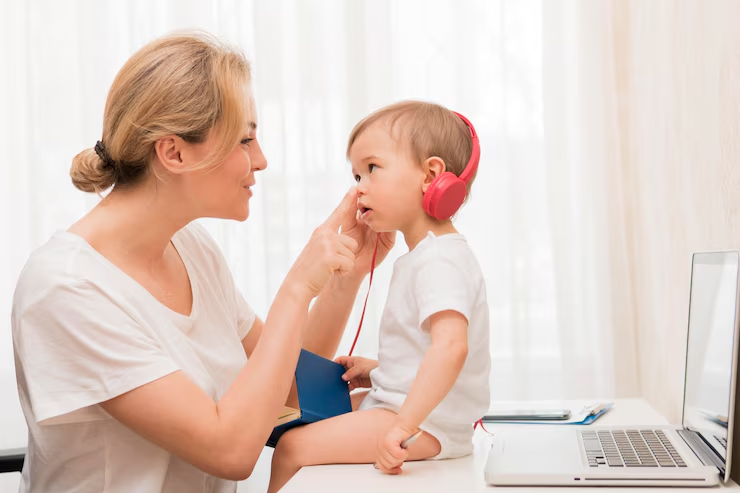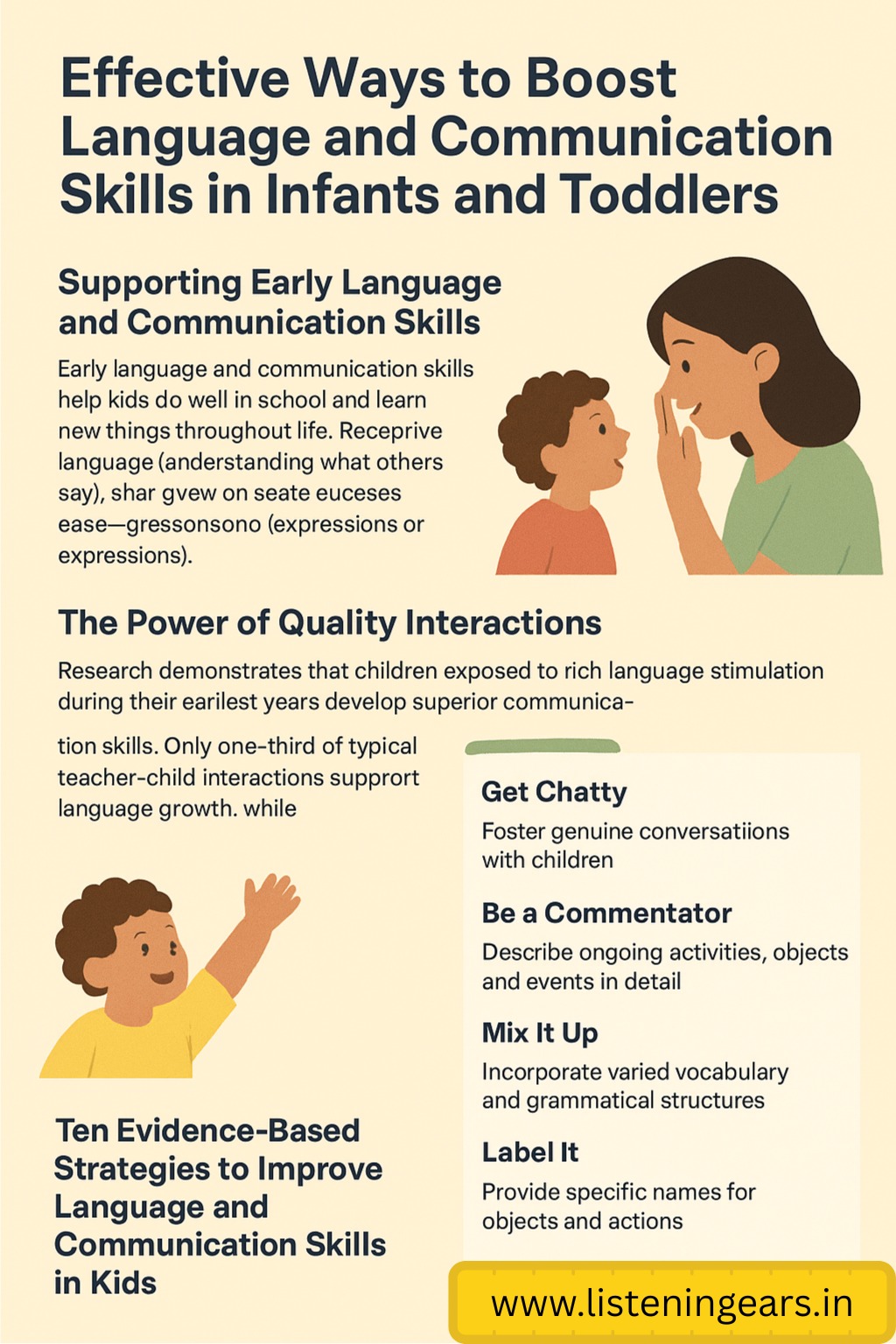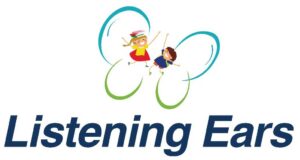
Supporting Early Language and Communication Skills
- Early language and communication skills help kids do well in school and learn new things throughout life. This means being able to understand what others say (receptive language) and share your own thoughts clearly using words, gestures, or expressions (expressive language). Kids who are good at talking and listening often find reading easier and do better in school. In fact, about 1 in 5 children in the U.S. have delays in language development, which can make reading and learning harder if not supported early.The first few years of life are very important for learning these skills. Talking, reading, and playing with adults helps children’s brains grow fast. According to the American Speech-Language-Hearing Association (ASHA):
Children with strong early language skills are 4 times more likely to succeed in reading by first grade.
- Kids who engage in frequent conversations with adults learn about 3,000 new words every year.
Parents and teachers can help by asking questions, telling stories, singing songs, and having lots of conversations. These activities help kids become confident, strong communicators and ready for school.

The Power of Quality Interactions
Research demonstrates that children exposed to rich language stimulation during their earliest years develop superior communication skills. When educators engage children through questioning, respond to their attempts at communication, and maintain positive dialogue, children expand their vocabulary and language use. However, studies reveal that only one-third of typical teacher-child interactions truly support language growth, while the remaining two-thirds consist of basic directions, simple praise, and questions that don’t require thoughtful responses.
Ten Evidence-Based Strategies to Improve Language and Communication Skills in Kids
Core Interaction Principles
The following approaches are grounded in research showing their effectiveness in promoting language development:
- Responding to Communication Attempts: Acknowledging and building upon children’s vocalizations and speech
- Shared Focus: Engaging in joint attention activities with children
- Conversation Initiation: Starting meaningful dialogues with young learners
- Expanded Talk: Increasing the quantity and quality of verbal interactions
- Rich Language Use: Incorporating complex grammar structures and diverse vocabulary
- Detailed Information: Offering comprehensive descriptions of objects, emotions, and experiences
The Ten Practices
- Get Chatty – Foster genuine conversations with children
- Be a Commentator – Describe ongoing activities, objects, and events in detail
- Mix It Up – Incorporate varied vocabulary and grammatical structures
- Label It – Provide specific names for objects and actions
- Tune In – Follow children’s interests and build upon their curiosity
- Read Interactively – Use books as tools for active engagement
- Read It Again and Again and Again! – Embrace repetitive reading for deeper learning
- Props, Please! – Introduce engaging objects that stimulate discussion
- Make Music – Incorporate musical activities into learning
- Sign It – Combine gestures and simple signs with verbal communication
These strategies work best when used together. For example, a teacher can play with a child’s favorite toys while talking about what they see and naming the objects. This helps the child learn words and understand what things are at the same time.
Evidence-Based Language Promotion Strategies for Early Learners
| Strategy/Practice | Description | Purpose/Benefits | Implementation Example |
| Get Chatty | Foster genuine conversations with children | Builds two-way communication skills and encourages active dialogue | Start meaningful conversations beyond basic directions; engage in back-and-forth exchanges with children |
| Be a Commentator | Describe ongoing activities, objects, and events in detail | Provides rich language exposure and detailed information about the world | Narrate what children are doing, describe objects they’re exploring, explain events as they happen |
| Mix It Up | Incorporate varied vocabulary and grammatical structures | Expands language complexity and introduces diverse language patterns | Use complex grammar structures, introduce new vocabulary words, vary sentence types |
| Label It | Provide specific names for objects and actions | Builds vocabulary and helps children connect words to concrete items and activities | Name specific objects, actions, emotions, and experiences as they occur |
| Tune In | Follow children’s interests and build upon their curiosity | Responds to communication attempts and maintains shared focus on child’s interests | Observe what captures a child’s attention and engage in conversation about those interests |
| Read Interactively | Use books as tools for active engagement | Promotes conversation initiation and expanded talk through literature | Ask questions during reading, discuss pictures, connect stories to children’s experiences |
| Read It Again and Again and Again! | Embrace repetitive reading for deeper learning | Reinforces vocabulary, allows children to predict and participate, deepens comprehension | Reread favorite books multiple times, encouraging children to join in and anticipate what comes next |
| Props, Please! | Introduce engaging objects that stimulate discussion | Creates opportunities for detailed descriptions and rich language use | Bring in interesting objects that spark curiosity and generate conversation |
| Make Music | Incorporate musical activities into learning | Supports language rhythm, memory, and pattern recognition through songs and rhymes | Sing songs, use rhymes, incorporate music into daily routines and learning activities |
| Sign It | Combine gestures and simple signs with verbal communication | Supports dual language learners and children with different communication styles; adds visual support to verbal language | Use hand gestures and simple signs alongside spoken words to reinforce meaning |
Building Language-Rich Environments
Developing effective communication skills requires immersive, language-rich surroundings. Just as the linguistic richness of home environments influences children’s language abilities, educational settings can powerfully support communication development.
Essential Environmental Elements
Effective early childhood programs promote communication by:
- Creating Safety and Security: Establishing environments where children and their unique communication styles are valued and respected
- Thoughtful Physical Design: Arranging spaces that naturally encourage interaction and communication
- Teaching Communication Conventions: Helping children learn essential skills like listening, turn-taking, and constructive conflict resolution
Creating a Safe and Supportive Space for Children to Communicate
Many children, like Alberto in our example, may hesitate to communicate when they don’t feel emotionally secure. Some children appear unresponsive not because they cannot communicate, but because they don’t feel safe enough to express themselves freely.
Building this essential security requires accepting and valuing the language children bring from their home environments. Children don’t learn language through correction or criticism. Consider this scenario: When Brooke excitedly shares, “I seen a deer on the way to school,” repeated corrections about grammar kill her enthusiasm and teach her that her natural way of speaking isn’t acceptable, without actually helping her learn proper grammar.
Supporting All Learners
These ways of helping kids talk and understand words are good for all children, even those who speak more than one language. Kids learning two languages at the same time might sometimes feel left out or have trouble talking with others. Using these helpful practices makes it easier for them to join in, make friends, and share their ideas.
Remember, every child learns at their own speed. Things like age, personality, and the language they hear at home can make a difference. When teachers use these proven methods, all kids get a chance to learn lots of words, talk confidently, and become great communicators.
If you think your child might be facing hearing-related challenges, it’s a good idea to explore hearing and listening resources to make sure hearing issues aren’t affecting language development.
Recent Happenings at Listening Ears
Listening Ears recently organized a Toddler Talk & Play Session, where parents and children explored fun ways to boost early speech and communication. Through songs, storytelling, and playful interaction, our therapists showed families how everyday conversations and activities can help little ones learn new words faster.
Our Area of Focus
Our Speech-Language Therapy Team specializes in supporting infants and toddlers with language delays. By combining interactive play, gestures, and rhythmic speech exercises, they help children build strong listening and talking foundations from the very beginning.
Final Note:
Talking, singing, and playing with babies and toddlers every day helps them learn words, understand others, and share their own thoughts with confidence. Every small chat, song, or story makes a big difference in how they grow and communicate.
At Listening Ears, we love helping little ones find their voices. Our programs support families in building strong language and communication skills—so every child can express themselves clearly, happily, and with confidence.
FAQ's
Why is it important to learn to talk and listen well?
Good talking and listening skills help kids do better in school, make friends, and understand the world around them.
What is the difference between understanding and speaking?
Understanding what others say is called receptive language, and using words, gestures, or signs to share your thoughts is called expressive language.
How many words can kids learn by talking a lot with adults?
Kids who have lots of conversations with adults can learn about 3,000 new words every year!
What can teachers and parents do to help kids learn words?
They can ask questions, tell stories, sing songs, read books together, and talk about things children are interested in.
What are some fun ways to help kids learn language?
- Talk about toys while playing
- Read the same book many times
- Use songs, rhymes, and gestures
- Show interesting objects and describe them
Why is it important for kids to feel safe when learning to talk?
If kids don’t feel safe, they might not try to talk. Being encouraged and respected helps them practice and grow their language skills.
Can kids learning two languages at the same time do well?
Yes! With support, dual language learners can join in, make friends, and communicate confidently.
What happens if a child makes mistakes while talking?
Making mistakes is normal! Kids learn better when adults encourage them instead of correcting them all the time.
